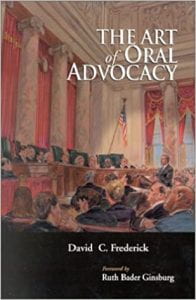The Art of Oral Advocacy
By David C. Frederick
Date of Publication: 2003
261 Pages
3.7/5☆
What is this book about?

In The Art of Oral Advocacy, author David C. Fredrick offers advice on how to prepare to argue in court. With his experience of arguing over 100 appeals, including 55 before the Supreme Court, in cooperation with several private practitioners and members of the Solicitor General’s Office, Fredrick breaks down the “art” of presenting a Moot Court argument from the preparation to process, to approaching the oral argument, and attributes of the best advocate. The book is broken down into seven sections for the reader to analyze every aspect of the oral argument and understand how to master Oral Advocacy.
What I Liked About the Book
What I enjoyed most about this book is the set up. The chapters in this book create the seven-section breakdown for the reader to understand what is necessary to prepare for a moot court argument. The breakdown of this book is simple, yet effective. Each section offers a series of examples pertaining to the advice given for the reader to understand why each principle, technique, or skill, is effective. In addition to the examples within the chapters, David Fredrick provides a five-part appendix with longer examples for the reader to digest. The appendices include a checklist for preparation and podium binders which is what you would bring with you to court and up to the podium, examples of openings of the appellant and appellee, effective mid-argument advocacy, and model rebuttals.
Although there is a distinction made early on about the appellate oral argument versus the trial argument, in reading this book from the perspective of a mock trial student, I enjoyed the fact that while this book offers sound advice for moot court arguments, in almost all sections, this advice can also be applied to the mock trial advocate. Fredrick writes not from the perspective of “how to” but more from the perspective of what the principles of effective oral advocacy are.
A piece of advice that stood out to me the most was when Fredrick discussed the speaking styles of the oral advocate. Fredrick writes “counsel’s first instinct arguing in a large courtroom might be to speak with a big voice and fill up a room . . . the best advocates maintain a low-key, conversational tone with the court.”[1] In addition to nerves that cause advocates to speak loudly or with quick cadence, advocates tend to interpret their role as an advocate to “argue” before the court. I put argue in quotations as the term “argument” gets misconstrued; there is no need to come off to the court aggressive and argumentative as this is not going to make you look good. You want to ensure that the court not only respects you as an advocate but trusts what you are saying. Cool, calm, and confident without being cocky is key in the world of oral advocacy.
What I Didn’t Like About the Book
While the chapters in this book, and the breakdown points within each section, are not long, the book did feel a bit repetitive at times. The book has a section early on about the principles and techniques of the oral argument, transitions into preparation, and what you will be dealing with during your in-court argument, and then transitions back to approaches to oral arguments where some of the same concepts were repeated. While it did not happen too frequently, it was enough for me as a reader to question why I was reading some of the same ideas again when they had already been discussed at length earlier in the book.
While this may be a biased portion of my review as I am solely a mock trial advocate, the sections that strictly applied to moot court arguments (i.e., “types of commonly asked questions” and certain portions of the common mistakes in oral arguments) were a little slow to read. I will preface this by stating that if I were still a 1L who had to prepare a moot court argument and an appellate brief, I think I would have enjoyed this book a lot more as these tips would have been helpful for those exercises. Given the fact that I do not have any interest nor aspirations to argue appeals, I read through these sections wondering when I would get to the next section to see if the insight provided were something I could apply to my mock trial advocacy.
What This Book Taught Me
The book begins with an explanation on why oral advocacy is so important; “Justice Ruth Bader Ginsberg notes that, in her years as a circuit court judge and Supreme Court Justice ‘I have seen several potential winners become losers in whole or in part because of clarification elicited at oral argument.’”[2] If you have taken a class with Professor Hatcliffe, or had to opportunity to listen him speak about trial advocacy you know that he tells his students the #1 rule of trial advocacy is to “always look good.” I find this rule relevant to discuss as this book elicits that exact idea. An advocate can have a winning argument submitted to the courts by brief, but if you are unable to build credibility with the court through your oral presentation what you have written in a brief simply does not matter. As an advocate, this is something I continue to consider and continue to struggle with. I can have a strong direct examination, cross examination, opening statement or even a closing argument drafted on paper and when I stand before a judge and jury the tone in which I present my questions or argument can make or break my credibility with the court. As an advocate, I have also learned the value of preparation, which is another theme throughout this book. As an advocate, we cannot always prepare for what is going to happen when we argue an issue or present a case in court. As an oral advocate, you are only partially in control of your presentation as you are constantly questioned on legal issues, case precedent, and underlying policies. In trial arguments, you are more in control of your argument, however there are still risks and roadblocks with presenting your case throughout the course of the trial. Being able to think quickly on your feet, and adjust to changes all while maintaining a professional demeanor is not a skill that comes naturally to most. Advocacy is an art, and this art takes tools, technique, and practice.
How I Will be a Better Advocate as a Result of this Book
While The Art of Oral Advocacy is divided into seven sections, the biggest take away I had from this book fall within the following principles and techniques of oral advocacy;
- Have a Mantra
- Lay Out Your Affirmative Points
- Prepare Defensively, Argue Offensively
In the world of Oral Advocacy, a mantra is “a phrase or sentence to repeat several times so that it becomes the theme of the argument.”[3] A theme is so important in both Moot and Mock as your case can all boil down to one singular phrase or sentence. As an advocate, it is easy to get lost in the thick of a case as there are several moving parts, issues, and arguments to be made. An advocate can have a clear path as to where their argument is going, and one additional detail or one small theory can turn the case around. With a mantra, you can always ensure that you are staying on track. Not only can this ensure that you as the advocate are staying on track, but a constant reminder of your mantra to your judge and/or jury ensures that they are also staying on track. It is easy to lose your audience, especially in an argument filled with a lot of details. A mantra is the listener’s reminder as to what your argument is about and provides them with a simple term or phrase to remember when it comes time to reach a verdict.
Subsequent to your mantra are your affirmative points. Affirmative points are the “critical points within your argument that provide substance to your mantra.”[4] These points also allow the court to understand why they should accept your argument. Given this explanation, I see the mantra/affirmative point relationship like a sandwich. Professor Hatcliffe often explains trial advocacy like a sandwich, but I would make the same or similar argument regarding mantra and affirmative points. You cannot make a sandwich without bread. The mantra is the bread of your argument as it will always be a part of your case. Now there are all different kinds of sandwiches in the world, however each individual sandwich has a particular recipe for you to be convinced, for lack of a better term, that the type of sandwich you have is what it claims to be. The contents of your sandwich are your case’s affirmative points. Within your case, you can create all different kinds of arguments through a plethora of different points, but you cannot convince a court of your argument/stance unless you have a strong recipe of affirmative points.
The final important principle is to prepare defensively but argue offensively. With regard to moot, this idea is conveyed by explaining to the advocate that in preparation, you may prepare to give the best and most satisfactory answers to the questions posed as possible.[5] What this means is that the answers you prepare to questions posed often times are defensive; the questions are posed to attack the point you are making and your initial reaction is to become defensive in order to satisfy the question. Defensive responses tend to have an aggressive tone and attack the question posed. The principle conveyed here is that instead of being defensive, argue offensively. The offensive approach occurs when responding to a question where, rather than becoming defensive, the tactic is to use a response opportunity to persuade the court. Instead of using the opportunity to attack back, use the opportunity to clarify and remind the court of the point you are trying to make. The same can be applied to mock trial. My interpretation is that you must prepare your best argument. This is initially done in your opening statement and your affirmative points, then present them in your direct and cross examination. If you prepare your line of questioning defensively, but argue offensively, you are likely to persuade the court in your favor. In trial, opposing counsel will have an opportunity to argue against your case, whether that be in openings, direct, or via cross. If you prepare defensively, when you respond through re-direct or cross examination of opposing counsel’s witness, you can use the opportunity to act offensively. Offer explanations to the court and use your line of questioning to focus on your affirmative points. In closing arguments, you have to opportunity to take what opposing counsel stated, acknowledge an argument, and re-focus the judge and jury on your affirmative points. Without being defensive, you can likely persuade a judge and jury to understand and favor the argument you are making.
[1] Fredrick C. Douglas, The Art of Oral Advocacy, 187, (2003)
[2] Id. At 3
[3] Id. At 84
[4] Id. At 86
[5] Id. At 96


Will add this to my reading list.
Great article Alex!! I’m so glad to see Booklore was passed down to you and I look forward to reading the rest of your articles!